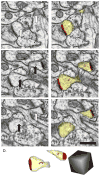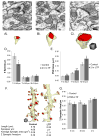Nanoscale analysis of structural synaptic plasticity
- PMID: 22088391
- PMCID: PMC3292623
- DOI: 10.1016/j.conb.2011.10.019
Nanoscale analysis of structural synaptic plasticity
Abstract
Structural plasticity of dendritic spines and synapses is an essential mechanism to sustain long lasting changes in the brain with learning and experience. The use of electron microscopy over the last several decades has advanced our understanding of the magnitude and extent of structural plasticity at a nanoscale resolution. In particular, serial section electron microscopy (ssEM) provides accurate measurements of plasticity-related changes in synaptic size and density and distribution of key cellular resources such as polyribosomes, smooth endoplasmic reticulum, and synaptic vesicles. Careful attention to experimental and analytical approaches ensures correct interpretation of ultrastructural data and has begun to reveal the degree to which synapses undergo structural remodeling in response to physiological plasticity.
Copyright © 2011 Elsevier Ltd. All rights reserved.
Figures




References
-
- Bourne JN, Sorra KE, Hurlburt J, Harris KM. Polyribosomes are increased in spines of CA1 dendrites 2 h after the induction of LTP in mature rat hippocampal slices. Hippocampus. 2007;17:1–4. - PubMed
-
- Bourne JN, Harris KM. Coordination of size and number of excitatory and inhibitory synapses results in a balanced structural plasticity along mature hippocampal CA1 dendrites during LTP. Hippocampus. 2011;21:354–373. Three-dimensional analyses of dendritic segments revealed significant structural plasticity of both excitatory and inhibitory synapses following the induction of LTP with TBS. Turnover of spines within t Three-dimensional analyses of dendritic segments revealed significant structural plasticity of both excitatory and inhibitory synapses following the induction of LTP with TBS. Turnover of spines within the first 30 minutes led to a decrease in small thin spines by 2 hours that was perfectly counterbalanced by an increase in PSD area, such that the summed PSD area per unit micron length of dendrite remained constant between control and LTP conditions. These data suggest that structural synaptic scaling may be an important cellular mechanism of plasticity in the mature hippocampus.he first 30 minutes led to a decrease in small thin spines by 2 hours that was perfectly counterbalanced by an increase in PSD area, such that the summed PSD area per unit micron length of dendrite remained constant between control and LTP conditions. These data suggest that structural synaptic scaling may be an important cellular mechanism of plasticity in the mature hippocampus. - PMC - PubMed
-
- Fiala JC, Allwardt B, Harris KM. Dendritic spines do not split during hippocampal LTP or maturation. Nat Neurosci. 2002;5:297–298. - PubMed
Publication types
MeSH terms
Grants and funding
LinkOut - more resources
Full Text Sources

